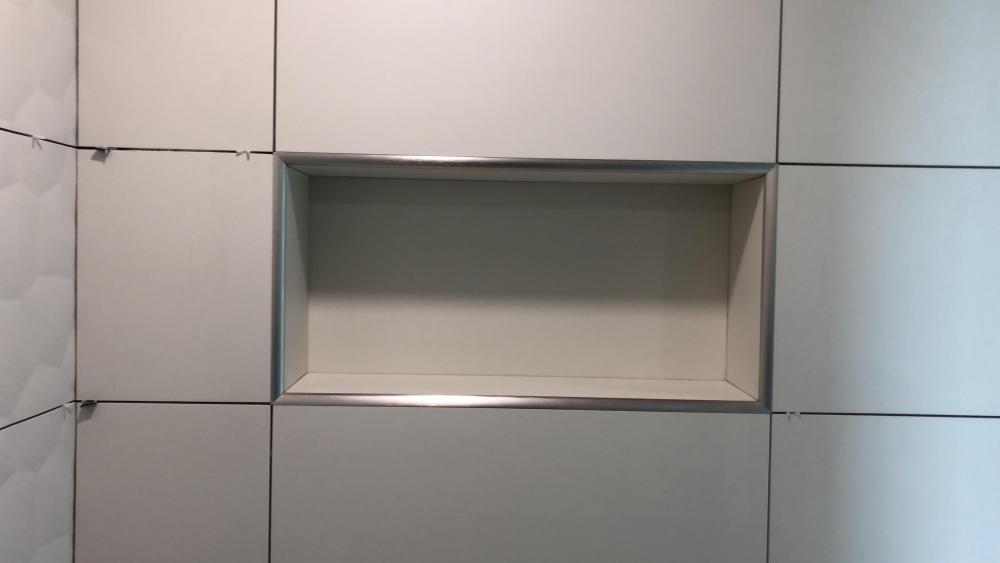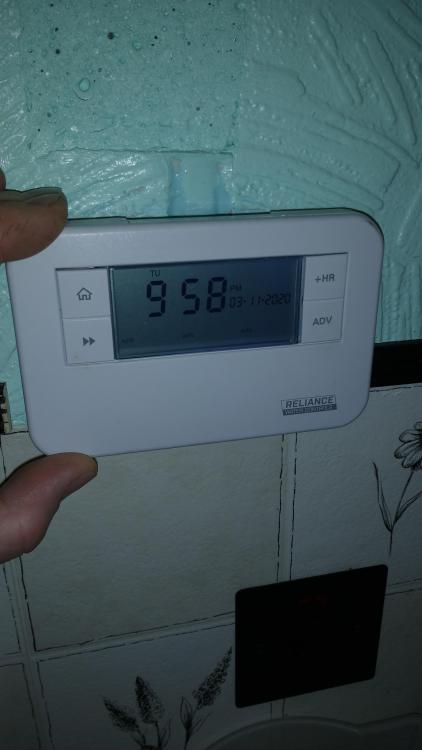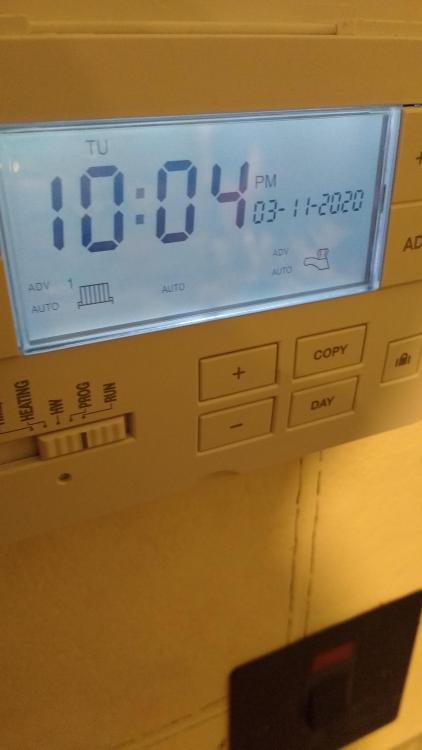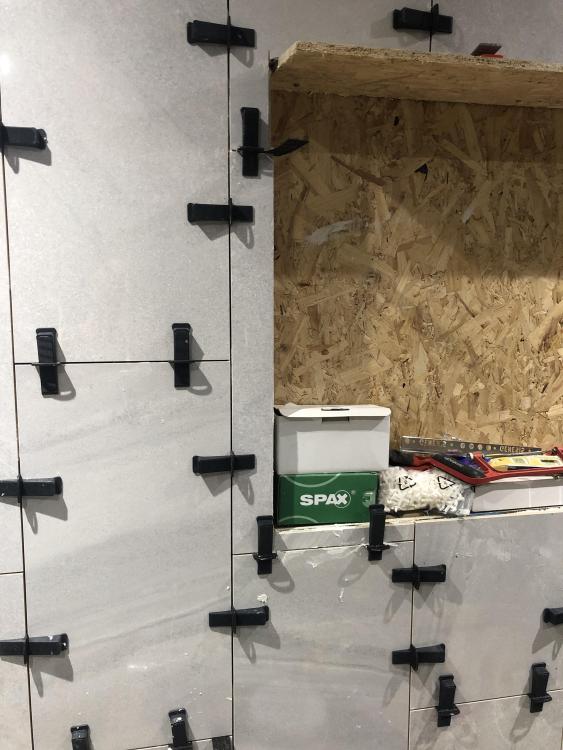Leaderboard
Popular Content
Showing content with the highest reputation on 11/04/20 in all areas
-
Unfortunately I have come across this attitude before but quickly nipped it in the bud by talking about the build process and using words they didn’t expect a woman to know, can’t stand men like that and certainly wouldn’t give them my business. Hubby had put some of them in their place too when they tried to address him instead of me and he turned round and said there’s no good talking to me you need to talk to the boss!3 points
-
Time over time, I read on here that ASHPs are no good for old houses. Can we stop this nonsense. ASHPs, or any heating system, if it has a too lower power output, will struggle. That is what power means. So rather than say an ASHP will struggle, or is the wrong thing to install, tell the true story. The true story is that it may be cheaper overall to install a gas or oil boiler, or a much larger, or even two, ASHPs. And could everyone stop getting temperature, energy and power confused, they are different thing.2 points
-
2 points
-
Thanks guys, we might have cracked it. When he serviced the boiler the guy turned it up to MAX. It was sitting at 80C. I normally have it set closer to 60. Let see if the manifold cools down and the pump magically fixes itself.2 points
-
I'm out too. The 12 pages have been interesting but we're going round in circles now.2 points
-
I completely agree... I have a 4kw ASHP that I did no calcs for and to be fair is woefully undersized for the job as it turns out. But I bought it cheap whilst drunk from ebay on a whim, a year before I fitted it. It’s perfect for my downstairs UFH, just too small for my rads upstairs (on very cold days upstairs is about 19*c tops). It also does my dhw with a bit of support from the immersion. My house is partly 300 year old stone and crud walls (no insulation), and partial new build (to basic building regs level of insulation). We have 2 lots of bifold doors, 3 patio doors, 2 chimneys, so the place is a little drafty (certainly compared to the builds on here). My total energy usage for a year is about 7000kwh. (My wife and I both work from home, and both my wife and daughter would like the house to be about 35*c if they had their way). So I guess I am saying that even in the ‘wrong’ type of house and being incorrectly sized, I still think it’s a great solution and would definitely do it again. I am however keeping an eye out for a higher kw unit to upgrade when I can.2 points
-
Precisely Years ago I bought a 1930's semi detached house with 9" solid walls. It had a large storage heater in the living room. That proved woefully inadequate to heat the room in winter even at it's maximum setting. So I had to light the coal fire, use a fan heater, or later I installed a gas fire (much later I installed central heating) But that does not mean "storage heaters don't work" just because that one heater was inadequate for that particular room in that particular house. I think the REAL issue is there are bands of installers going around fitting poorly designed / sized ASHP systems that then turn out not to work properly and it is those poor installs that get "heat pumps" a bad name. I know perhaps half a dozen houses with an ASHP and they were all designed properly and working well. Perhaps it is time for the law to state clearly that someone designing a heating system should warrant that it will work in all normal weather conditions for the house and it's location.2 points
-
2 points
-
Batteries should still reduce in price over coming years, and some systems allow you to buy small and incrementally increase capacity. So for your goals, I'd do the 8K now and live with it a year or two and see how much juice you are exporting and make a call how much battery to get down the line (if any). Correction: this in not what I would do, it really is what I currently am doing. Also: if the goal is planet saving it is immeterial if you're using the home grown PV electricity yourself or feeding it to the grid. Each additional kWh you generate is one less needing to come from gas. (Caveats abound)2 points
-
Thanks very much @Nickfromwales and everyone else. When the pubs open up if you’re round my way I owe you all a drink. Two things I have learned. Check your boiler after it gets serviced. Those things that look like temperature probes in the manifolds will switch off your UFH if they get too hot.1 point
-
1 point
-
1 point
-
The efficiency is not set by the type of building, it is set by the load cycle. So the question is wrong really.1 point
-
1 point
-
1 point
-
Check it is getting power first. Those pumps have a plug in power cord, check it has not come loose.1 point
-
Good points @MortarThePoint One way of looking at Mortar's question particularly, to sensitive doors (say some bifolds, sliding doors) in wide openings is to start with the finished article and work back. Steel beams - First split the loading on the lintel up into two types; you have the dead weight (dead load) bricks, blocks, floors and roofs etc. You can calculate how much the beam will bend (deflection) under this load. Now the bottom of the beam will not be flat but bowed down in the middle. But the dead load tends to be fairly constant, give or take moisture content changes in the materials and so on.. You can allow for this initial defection when taking the ball park first door sizes. Next you calculate what the extra deflection will be when you get say snow on the roof, have a party, fill the house with book cases etc, that is called the live (imposed load) deflection. Now you can add the two deflections together and this gives the overall deflection. Just remember that when say the snow melts the beam will move back up a bit. Let's say you have an opening 4000 mm wide. You can start by saying let's keep the deflection limit under imposed loading to say span / 360 = 4000 / 360 ~= 11.1mm, maybe a bit too much for sensitive doors. Plug this 11.1mm (or a lower value) deflection back into the formula that Mortar gives and this will give you the beam second moment of area, now go to the tables and find a beam with a greater value than this. Next go back and calculate the overall beam deflection under dead + live load, and just as a check do the imposed load only again. Have a look at the figures you get and cross check with the door manufacture's tolerances in terms of deflection, they generally won't be too forgiving. Now you have got a handle on the beam size that you need to control the deflection. The next thing to do it to check that the beam will be safely carry all the loads, these are the "strength checks". Now you are nearly there. It's tempting to stop there as you think.. well I know what I need to allow for beam deflection, I'll just give it a few millimetres for the mastic seal. But mastic is not as compressible as you think when it is thin, you can accidentally transfer load to the tops of the doors, they bend and start to stick. The last part of this jigsaw is to detail the seals / insulation so you avoid transferring load to top of the doors. Cold formed steel "Catnic" type lintels These are a bit of a different animal. Generally they are designed with similar deflection criteria to the above. However, you need to look closely at what is called the "load ratio" A cavity lintel supports the inner and outer leaves. The two leaves have different loadings and this can cause the lintel to twist a bit as well as bowing downwards. if you follow the manufactures guidance (particularly the installation instructions) to the letter then the lintel should be safe. I think the key here is to get the detailing right in terms where and how you allow the beam / cold rolled lintel movement to take place. This is not that easy when you are trying at the same time to prevent cold bridging and so on. With big expensive doors that are not that tolerant to vertical deflection, loading on the top side I would look to start with a lower deflection limit, design the beam for that, detail the vertical movement joint over the doors and see if it looks pleasing to the eye and fits with the insulation detail. All easier said than done as a lot of the aluminium sections are pretty slender these days. If you have steel Universal beams and an expensive glazing system you can put a bit of precamber on the beams. In other words you work out the deflection, pre bend the beam up so that when the load is applied the bottom of the beam is flatter rather than bowed down. It's not that expensive to do on modest sections funnily enough. look at how flat the underside of the beam needs to be.1 point
-
I feel your pain. We are a same sex female couple and it's bloody hard work at times. I continually feel like I have to battle more than a guy would and thank god for this forum I can go back and ask relevant questions or be firm with things and pretend I know what I'm talking about. It's not so much our builder now who knows not to try that sh!t with me although I do get the sense would treat a guy differently. Only this week the ASHP contract people said to me they were sure after I'd shown the updated spec to my husband he would understand it more than me ?1 point
-
1 point
-
Id agree with @nod but that assumes you've planning, building warrant and funding in place. If not add 6-8 months minimum.1 point
-
Wow I never thought of that; I've been toying with the idea of one of those ammeters where you stick the wire through a coil but a switch sounds a much simpler and more accurate idea. I'll look into it thanks. Also, @SteamyTea and couple of other people expressed an interest in the logger, so I made a web page for it.. http://whatsnormal.org/sunamp-logger/sunamp-logger.html1 point
-
Sisters :)) Same experience here, although nipped in the bud. Early on in the project whenever the builders and our PM and myself would get together, talking as a group they completely ignored me (regardless of me having more info and thinking times quicker then all of them put together). They just do not hear when a woman is trying to put in a remark or make a suggestion. All full of themselves. I had to seriously raise my voice on one occasion and very loudly and clearly state that I WANT TO SPEAK and I WANT YOU TO LISTEN CLOSELY. You should have seen the look!.. Since then, we've changed the builders to a really nice one who actually maintains eye contact when listening and makes a real effort to answer specifically. I've had the same experience in my 20 years of corporate City meetings - whenever you are in a meeting room full of men, you don't exist until you put a double effort into being heard. Boys club. Read somewhere that men are not wired to hear female voice frequencies Actually lowering my voice when talking REALLY helps - this is astonishing. On a positive side, our local timber & builder merchant shop (a large one) is really female-friendly, and I am always treated with respect. By the end of the project they know my name, ask after the family, the son, the cat, the neighbours, etc. I only have to walk in and say "guys, I need this thingy... you know... the square white one with a metal thingy on top" (or close), and they immediately produce that very thing, and we joke about it. Really nice as a result they got £££'s worth of our business in the past 6 months.1 point
-
1 point
-
I said this pages ago, @PeterW said this above. But you still keep asking questions about how YOU are going to sort it out. As said above you have a contract with however designed/installed it, get them to sort it out, that’s their job/responsibility. I designed and installed my own and it works very well but if I cocked it up I have no one to blame, YOU DO.1 point
-
Another idea might be to raise your concern that you are upgrading the network for future houses. See if you can get a legal undertaking, that if future houses are connected to "your" new cable then the other new houses should be charged a fair proportion of this upgrade work and that money refunded to you.1 point
-
The problem with that is: will the op be building the houses himself? We had this Scenario when we were handed a quote for £25k for connection, there is a piece of land next to us with pp for 5 houses and we approached the owners of it to see if they would be willing to share the cost of the new cable required but they had no intention of building the houses so weren’t interested although they didn’t tell us that straight out, just disappeared off our radar. The energy company weren’t interested in the fact that there were going to be more houses requiring connections either, they said until they made an application for a connection they could only charge us for it and when or if more applications were made for connections (providing this happened within 5 years) we would get a refund. Luckily it all worked out for us as I have documented elsewhere and nearly 3 years down the line the other plots remain undeveloped.1 point
-
1 point
-
1 point
-
Under contract law (and you still have a contract as someone has paid for this on your behalf) the installer is at fault and it is up to them to put it right. They are the ones who designed, sized and specced it, Vaillant just provide the kit. It is like buying a new car from a dealership and them telling you that any issues you need to go to Ford / Vauxhall / VW to fix it... You wouldn't, you would go to the garage, even if it was under warranty. Email the installers, and also state you do not believe it is fit for purpose, and ask for a copy of the sizing calculations.1 point
-
Thanks ProDave. The chap from WPD told me that the current 95 cable is serving a pole opposite our driveway which provides the whole street. Maybe he wasn’t quite right about that... The new development will be in the field to the north of us, where the replacement cable is to be run through. It may well be a better option for us to wait and see if he gets planning consent, and then to come to an agreement to approach WPD to supply his five and our house, and we pay 1/6th of that cost instead.1 point
-
There is a growing trend for you to need qualifications and need to join some form of "competent persons scheme" before anyone will believe you know how to do it and indeed allow you to do it. AND STILL THEY GET IT WRONG.1 point
-
local agricultural outlet will prob be the cheapest for Hypo - dairy farmers use it for cleaning pipes so should be in stock.1 point
-
You mean too wide? 132-122=10mm. Wouldn't worry about it being 10mm wider. Get on and fit it! ?1 point
-
But your surveyors should have realised that an ashp is the wrong choice for your type of house, poorly insulated, esp as small a heat pump that you have been given. That's their job. To come out and do heat loss calculations and show that what they are going to install will be good enough to cover the losses. The fact they wanted to install extra insulation is a good indication that they didn't think it was suitable. To over come your heat losses you need water going round the rads that is 70 degrees or higher. An oil boiler would have been the wiser choice. It could run flat out and produce hot water fairly quickly. An ashp just won't be able to do this and maintain any degree of efficiency. Most here that have an ashp have very low energy builds so need very little heat to maintain that 20/21 setpoint.1 point
-
I have answered my own question so will post the answer in case anyone else is affected. The Land Registry quickly responded to my enquiry. for a name change you need to fill out their form but no fee payable. You need evidence with the new property name ie council tax bill. You also then need to fill out a COG1 form for a change in communication address to your new names house. This requires ID for all parties. I have sent copies of passports etc and hope it will suffice. Again no fee payable. All gone recorded delivery yesterday so we’ll see.1 point
-
If you want MLCP without the expense of one of those tools, try these: https://pswtradesuppliers.co.uk/ I used it for my manifold system for the radiators, and it worked a treat, same kind of system with 16mm pipe, aluminium core, and eurocones, but this has a compression nut instead of needing the tool for press fit.1 point
-
1 point
-
1 point
-
@PeterW put me onto this. Hasn't missed a beat: https://www.amazon.co.uk/dp/B00QVM6VK4/ref=cm_sw_r_cp_api_i_KMi2CbPSR3RNJ1 point
-
I have the Horstman H37XL I didn;t think there were very many 3 channel ones to choose from.1 point
-
I'm not sure if you have started building or not, but this very complicated detail is why we committed to a full footprint basement as all the insulation would be in the foundation slab. Doing a partial basement on our site made no sense. Otherwise, some sort of concrete slab (hollow core or block and beam) with DPM, 150-200mm PIR and then screed would be the way to do it. Avoiding cold bridging between your basement walls and the suspended floor slab will be critical.1 point
-
You would not normally need insulation to a floor above a basement. Bear in mind that the basement design may need a certain floor type to help support the walls. You will need to be careful if you have a suspended floor in the other part of the house as it would normally be ventilated and therefore cannot connect to the basement part. As per @Bitpipe, a full basement saves quite a few issues.1 point
-
Does the basement have a concrete lid or suspended timber? And will the ground floor have heating in it? If it's concrete then the above suggestion is probably the best way to go - create a contiguous ground floor and work off that. You'll find basements, however they are insulated themselves (internally or externally) do not have a very high heating requirement as they will maintain a year round ambient temperature due to being in the ground. If they're full of plant or equipment (TVs etc) then that all helps. Our basement is a passive design and has no heating at all but it's a full footprint so does not give us the issue you have.1 point
-
Is the basement going to be a heated/habitable room or just for storage? One option is to build a beam and block floor over the whole footprint and put insulation and screed on top.1 point
-
Local contractor in Ireland affiliated to Energystore Belfast. Don't think they cover Britain.1 point
-
1 point
-
That looks a fair bit neater than the first one you did. Less adhesive in the grout gap. Can you promise not to use piss yellow grout this time? It that a very big l-shape to the left of the mirror or did you cheat?1 point
-
Hi, 1) Humans are NOT good thermometers. Do put a simple thermometer up and see what temperatures are actually being achieved. 2) Please understand that the measure of a working system is NOT (repeat *not*!) whether the rads happen to feel hot or warm or cold when you happen to touch them, but how warm the room is (partly air temperature, partly surfaces). 3) Please just DO turn the temperature up as requested as an experiment, well over what you want, to test what happens. 4) Low (power) output does not necessarily mean low temperature. Rgds Damon1 point
-
Lintel schedule should be on the plans. I use Condell for them and send a list and get them all together on one order - usually get best price and merchant can’t match it. Plans get marked up and they then get sprayed with a number and the blockwork next to the opening gets the same treatment so there is no mix up as to what goes where.1 point
-
The filters in our last unit were simply cut from large sheets of filter media which you could buy per metre online (rather than pre-cut from the manufacturer at 10 times the price). http://www.justfans.co.uk/synthetic-air-filter-media-1000mm-1000mm-p-642.html?gclid=CJr1ha7yqMACFRDItAodxz0AHQ&osCsid=5tri9fcf5dksj8l7uc5gfddt84 The unit we have bought for the new house (Vent Axia) has the filter media enclosing a metal frame, but my good lady has already indicated she'll be able to sew a piece of filter media to fit round the frame as and when it requires replacement. This company came up as a source for reasonably priced filters on ebuild http://www.jfilters.com/1 point



















